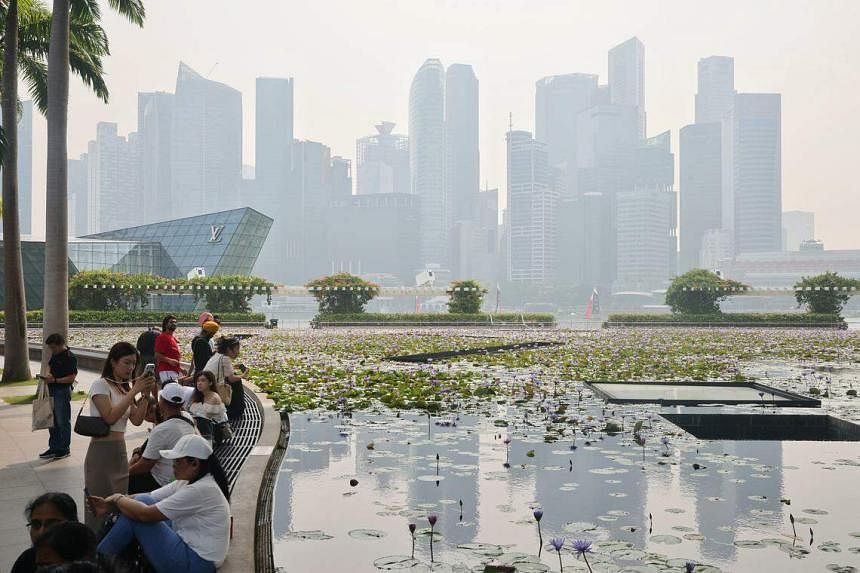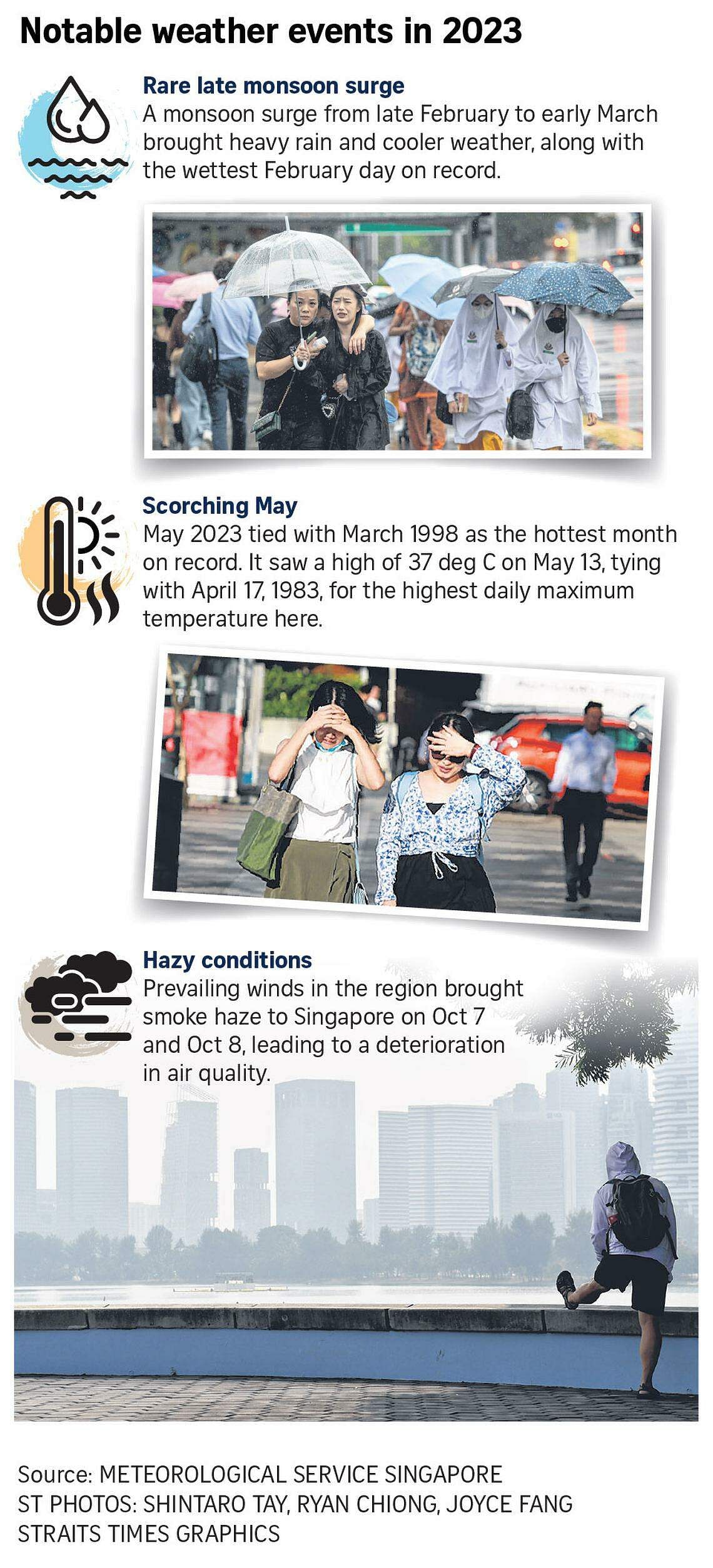SINGAPORE – If droplets of sweat bead your forehead the moment you step outdoors and run down your back despite an umbrella overhead, brace yourself.
The hot weather looks set to stay in 2024, and could be even warmer than the temperatures felt in 2023 – the fourth warmest year on record for Singapore, said the national meteorologist on March 23.
The forecast warm weather is due to the lingering effects of a climate phenomenon known as El Nino, which affected Singapore in the second half of 2023.
El Nino causes hotter and drier weather over South-east Asia, including Singapore, due to changes in sea surface temperatures and surface winds over the tropical Pacific Ocean.
“Since the warmest annual temperatures from any El Nino events typically occur the year after an El Nino forms both for Singapore and globally, 2024 could be an even warmer year,” said the Meteorological Service Singapore (MSS) in its annual climate assessment report.
The prediction of sweltering conditions in 2024 comes as the weatherman declared 2023 to be Singapore’s joint fourth warmest year since records started in 1929.
The annual average temperature of 28.2 deg C tied with those of 1997 and 2015 – both also El Nino years. The warmest years on record are 2019 and 2016 at 28.4 deg C and 1998 at 28.3 deg C.
In 2023, Singapore was affected by a “double whammy” of climate phenomena that caused warmer than usual temperatures.
Other than El Nino, positive Indian Ocean Dipole (IOD) conditions also beset Singapore in the second half of the year. Similar to El Nino, a positive IOD brings warmer weather to Singapore due to atmospheric and sea surface temperature variations across the Indian Ocean.
Singapore is located between the Pacific and Indian oceans, and can be affected by changes in conditions over both ocean basins.
“Both El Nino and positive Indian Ocean Dipole events are typically associated with warmer temperatures in Singapore, while La Nina tends to moderate Singapore’s temperatures,” said MSS.
While an El Nino event brings warmer, drier conditions over Singapore, its “crybaby” sister, La Nina, dumps more rain over the country. El Nino and La Nina refer to the warm and cool phases of the El Nino-Southern Oscillation (Enso), a natural climate cycle that can significantly affect weather patterns around the world.
In 2023, Singapore experienced both phases of Enso. La Nina conditions, which had developed in Singapore in 2021, ended in the first quarter of 2023.
Yet, despite the cool start to the year, monthly temperatures from April onwards were above their respective long-term averages, MSS said.
The La Nina conditions likely had a moderating effect on Singapore’s temperatures, said an MSS spokeswoman when asked why Singapore’s temperature records did not align with reports of 2023 being the world’s warmest year.
She added that it is expected that individual regions or countries will differ from the ranking for the global average.
In 2023, the warmest temperature anomalies were found mostly in northern regions, such as Western Europe, Northern Canada, and Central Asia, she said.

The MSS report, which covered Singapore’s main climatic features and notable weather records and events in 2023, also pointed out that the last decade – between 2014 and 2023 – has been Singapore’s warmest decade on record at 28.06 deg C.
This is 0.33 deg C warmer than the preceding decade.
MSS said Singapore’s warming patterns are in line with global trends.
The World Meteorological Organisation’s 2023 State of the Climate report showed that the nine years from 2014 to 2023 were the nine warmest years on record globally, and temperatures have been going up over those years.
Human activities, such as the burning of fossil fuels like coal, oil and gas, are the main cause of the rising temperatures. Combustion releases heat-trapping gases into the atmosphere.
MSS warned that with temperatures set to continue rising, figures from this decade would be considered cooler than average compared with mid-century from 2040 to 2059, according to future climate projections from Singapore’s Third National Climate Change Study.
Singapore also experienced 37 days with some period of high heat stress in 2023, and MSS warned that the number of such days could triple by 2050 if warming continues unabated.
Days of high heat stress refer to days when the hourly average Wet Bulb Globe Temperature is equal to or greater than 33 deg C, and such circumstances put people at greater risk of heat exhaustion and heat stroke.
The highest number of high heat stress days occurred in May 2023, at 10 days, followed by October, which had eight such days. Record-high temperatures and lower rainfall contributed to more periods of high heat stress in these two months, said the MSS.
Depending on the emissions scenario, Singapore could see between 53 and 155 days of high heat stress.
The MSS report also highlighted notable weather events in 2023.
Singaporeans would remember the hazy conditions in October that saw the iconic Marina Bay skyline clouded by a grey fog.
MSS said that a shift in prevailing winds on Oct 7 and 8 blew lighter smoke haze to Singapore after an escalation in hot-spot activity and the presence of smoke haze in the surrounding region.
They resulted in hazy conditions, with the air quality deteriorating into the unhealthy range over parts of the island on those two days. The highest 24-hour PSI of 123 was recorded in eastern Singapore between 8pm and 9pm on Oct 7.

Singapore also experienced a rare late wet monsoon surge in late February to early March, during the end phase of the north-east monsoon. On Feb 28, heavy rain from the monsoon surge brought 225.5mm of rainfall in Kallang – the highest daily total rainfall ever recorded in February.
The temperature dropped to 21.1 deg C in Newton, which was the lowest temperature recorded in 2023.
On the flip side, Singapore saw new maximum temperature records set in May as dry and warm weather set upon the island. On May 13, the highest daily maximum temperature of 37.0 deg C was recorded in Ang Mo Kio. This was not only the warmest day in May on record, but also tied with April 17, 1983, as the highest-ever temperature recorded in Singapore.
There were nine days in May when maximum temperatures were 35 deg C or above.
At the Changi climate station, both the monthly average daily mean temperature and monthly average daily minimum temperature recorded new highs for May, at 29.5 deg C and 26.7 deg C, respectively.

Correction note: An earlier version of the story said the World Meteorological Organisation’s 2023 State of the Climate report showed that the nine years from 2019 to 2023 were the nine warmest years on record globally. It should be 2014 to 2023. This has been corrected. We are sorry for the error.


